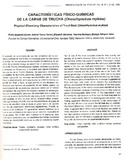Mostrar el registro sencillo del ítem
Características físico – químicas de la carne de trucha (Oncorhynchus mykiss)
| dc.rights.license | http://creativecommons.org/licenses/by-nc-sa/3.0/ve/ | |
| dc.contributor.author | Izquierdo, Pedro | |
| dc.contributor.author | Torres Ferrari, Gabriel | |
| dc.contributor.author | González, Elizabeth | |
| dc.contributor.author | Barboza, Yasmina | |
| dc.contributor.author | Márquez Salas, Enrique J. | |
| dc.date.accessioned | 2009-03-12T16:10:42Z | |
| dc.date.available | 2009-03-12T16:10:42Z | |
| dc.date.issued | 2009-03-12T16:10:42Z | |
| dc.identifier.issn | 0798-2259 | |
| dc.identifier.uri | http://www.saber.ula.ve/handle/123456789/27134 | |
| dc.description.abstract | El pescado es un alimento de los más completos por su calidad y cantidad de nutrientes; sin embargo poco se sabe sobre a calidad de los nutrientes de los criados en cautiverio. El objetivo del presente trabajo es determinar el potencial nutricional de la Trucha (Oncorhynchus mykiss), pescado que se cría consume en Venezuela, y comparar sus valores nutricionales con los de la Trucha silvestre. Se determino rendimiento, porcentaje de humedad, proteínas, lípidos y cenizas; esto se realizó siguiendo las técnicas recomendadas por la AOAC. Para la determinación de lípidos totales se utilizó la técnica sugerida por Bligh y Dyer, la cual permite la cuantificación, sin deterioro por razones de oxidación, de los ácidos grasos. La determinación de las proteínas totales se realizó por el método de Kjeldahl. Se analizaron los esteres metílicos de ácidos grasos por cromatografía gaseosa. Se determinó que el valor nutritivo de la carne de trucha de vida libre y la de estaciones experimentales de cría es muy similar, encontrándose diferencias significativas, P<0,05, sólo en los porcentajes de grasa; la trucha de vida libre tiene el doble de grasa que la de cautiverio. No se observaron diferencias significativas, P<0,05, en cuanto a las proteínas. En general los valores nutritivos de la techa son similares a los descritos en estudios realizados en otros peces. Por el alto valor nutritivo de la trucha se recomienda su consumo y por los resultados que arrojó el presente trabajo se recomienda continuar su cría en estaciones experimentales. | es_VE |
| dc.rights | info:eu-repo/semantics/openAccess | |
| dc.subject | Trucha | es_VE |
| dc.subject | Cautiverio | es_VE |
| dc.subject | Silvestre | es_VE |
| dc.subject | Valor nutritivo | es_VE |
| dc.subject | Composición proximal | es_VE |
| dc.title | Características físico – químicas de la carne de trucha (Oncorhynchus mykiss) | es_VE |
| dc.title.alternative | Physical-Chemistry characteristics of trout meat (Oncorhynchus mykiss) | es_VE |
| dc.type | info:eu-repo/semantics/article | |
| dc.description.abstract1 | Fish is one of the most complete foods for their quality and quantity of nutrients; however little is known on the quality of the nutrients of the fish raised in captivity. The subject matter of the present work is to determine the nutritional potential of a variety of fish that are bred and consumed in Venezuela, denominated Trout (Oncorhynchus mykiss) and to compare its nutritional amounts with the ones of the natural life Trout. Efficiency, percentage of humidity, proteins, lipids and ashes were determined using the techniques recommended by the AOAC. For the determination of total lipids the technique suggested by Bligh and Dyer was used, which enables the cuantification without deterioration for reasons of oxidation of the fatty acids. The determinations of the total proteins were carried out by the method of KjeIdahl. Analyses of methyl esters of fatty acids by gassy chromatography were made. In this experiment it was found that the nutritious value of the free life trout meat and the ones of experimental stations of breeding are very similar, only finding significant differences, P<0.05, in the percentages of fat; the free life trout has double the fat than that of captivity. Significant differences, P<0.05, were not observed for the proteins. In general the nutritious values of the trout are similar to those described in studies carried out in other fish. Based on the high nutritious amounts of the trout its consumption is recommended, and for this work’s outputs we recommend to continue with its development in experimental stations. | es_VE |
| dc.description.colacion | 27 - 32 | es_VE |
| dc.subject.institucion | Universidad del Zulia (LUZ) | es_VE |
| dc.subject.institucion | Universidad de Los Andes (ULA) | es_VE |
| dc.subject.keywords | Trout | es_VE |
| dc.subject.keywords | Captivity | es_VE |
| dc.subject.keywords | Wild | es_VE |
| dc.subject.keywords | Nutritious values | es_VE |
| dc.subject.keywords | Proximal composition | es_VE |
| dc.subject.publicacionelectronica | Revista Científica | |
| dc.subject.tipo | Revistas | es_VE |
| dc.type.media | Texto | es_VE |
Ficheros en el ítem
Este ítem aparece en la(s) siguiente(s) colección(ones)
-
Revista Científica - 1999 - Vol IX - No. 001
enero - febrero



